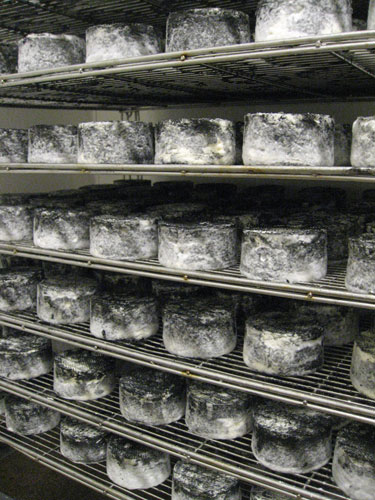Mt Townsend's Seastack- is it a goat, a cow, a ...?

While it doesn't provoke questions as perplexing as the recent discovery of a lamb-puppy in China, Mt Townsend's Seastack also leaves people with their eyebrows raised, wondering "which animal is it?" A cheese made in Port Townsend, Washington, Seastack weighs in at eight ounces and reaches an inch and a half high. It's creamy, buttery, tangy, and has a thin coating of ash beneath its plush white exterior.
Like Selles-sur-Cher, and numerous other goat's milk cheeses styled after the Loire Valley chevre crew, Seastack gets a dousing of vegetable ash after the curds have set. This inspires the growth of the penicilum candidum mold- the mold that creates the plush, brie-like rind on cheeses like Mt. Tam, camembert, Humboldt Fog, and Kurtwood Farm's Dinah. The mold helps the cheese look pretty, and keeps the inside soft and moist.
A slice of Seastack reveals a layered cheese. First comes the plush bloomy rind. Then, underneath the bloom, a thin strip of ash. Next, there is a soft, thin, off-white layer that glistens like silk. It's creamy and gooey. Beneath the silky goo is a slightly crumbly center. As the cheese ages, the silk goo takes over. It inches its way in, and the crumbly center has no choice but to submit to the cream (not a bad ultimatum).
It's rare one sees this type of layering with a cow's milk cheese. The layering resembles what happens with a goat's milk or mixed-milk cheeses as they mature- for example, like with Zingerman's Lincoln Log or mixed-milk La Tur. But Seastack is made entirely with cow's milk from Port Townsend dairies.
So how did the lamb come out looking like a puppy, you ask? I have my suspicions, but let's stay focused.
Seastack comes out layered and crumbly like a goat's milk concoction because it undergoes more lactic acid fermentation and gets less rennet than many soft bloomy-rinded cow's milk cheeses. After pasteurization, the milk is left out for hours to start acidifying and curdling on its own, rather than being provoked to coagulate early with rennet. The lactose sugars convert themselves to lactic acid, and when this happens, curds form just like when rennet is added to the milk. But different style curds form, and the cow's milk assumes tangy, slightly lemony flavors like it were goat's milk from this style of coagulation. Rennet is also added to Seastack, but it's prominent flavors and later textures are shaped by its lactic acid fermentation.
Besides the lemony flavors and awesome layers, Seastack tastes like fresh milk, a little like mushrooms depending on the batch, and like lively, cultured butter. It loves dried or fresh figs, sour cherry jam, Sauvignon Blanc, crémant sparklings and Cava or Prosecco. Like a certain girl I know.
Want to read more?
Have you tried Mt. Townsend cheeses? Do you have a favorite of theirs?